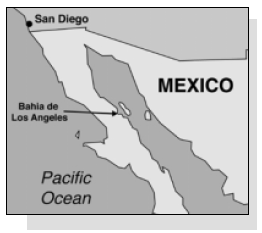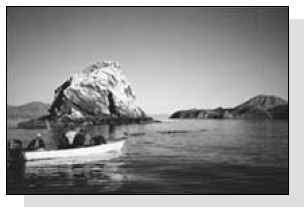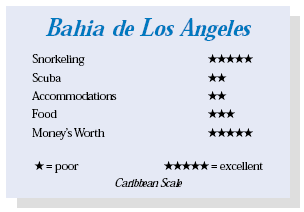Bahia de Los Angeles, MexicoContents of this Issue: Computer, Depth Gauges Recalled New Dive Possibilities, New Ripoffs Three Magazines for Experienced Divers Has Ocean Realm Sunk Without a Trace? Potential Valve Fire from a Nitrox Fill Editorial Office: Ben Davison Publisher and Editor Undercurrent 3020 Bridgeway, Suite 102 Sausalito, CA 94965 a ten-hour drive to guaranteed whale sharks from the August, 2002 issue of Undercurrent
Dear Fellow Diver: While filming an amateur documentary last year with my middle school students in Bahia de los Angeles, a laid-back fishing village of one thousand people, a student asked a fisherman about the animals that frequent the bay. Offhandedly, I asked, “Hay tiburones ballenas aqui?” (“Are there whale sharks here?”) To this day, I find it hard to believe what I found out. That February, my students and I spent a week with Antonio and Bety Resendiz, well-known sea turtle scientists who also run an eco-camp, where I learned about the incredible marine treasure that is Bahia de Los Angeles, and the emerging environmental controversy that will bring international recognition to this sleepy little fishing village. With repeated prompting, Antonio would patiently describe how every year whale sharks find their way to the southern part of Bahia de los Angeles and spend up to six months in the plankton-rich waters. He assured me, “Every year, same place...whale sharks guaranteed!” Only now, however, are the residents realizing the value of ecotourism, and many are alarmed at the large-scale development plans that are part of Baja’s Escalera Nautica tourism project. In September 2001, after driving nearly ten hours from
San Diego, I stopped in Bahia de los Angeles, a friendly
fishing village nestled between spectacular mountains and
the sea. Save for the usual rural Mexican smattering of
trash surrounding town, the beauty of the surrounding area,
with its towering cardon cacti and alien-looking boojums,
rivals any desert in the world. That day, I sometimes swam at full speed and other times kicked lazily, close enough to touch (although I didn’t) each of the three other whale sharks, mesmerized by the shifting pattern of white spots that reflected flickering rays of light toward the sky. I could see their markings and scars, dive underneath searching for “gender clues,” and look right down into their refrigerator-sized gullets. It was like being in my own front-row IMAX movie. Three weeks later, I returned with my family and swam with whale sharks all six days I was on the water. I swam lazily for hours with many of the whale sharks at arm’s length, observing amazing feeding behavior, avoiding head-on collisions, and learning to spot individuals and their unique behaviors. We were often the only boat around. Whale sharks begin arriving in June (just this year they came in late May) and stay into early to mid-November. Summers are hot (often exceeding one hundred degrees) but there is always relief on the water. As you get close to November, the water and air generally cool, but the threat of nortes (northern wind) increases, which prevents boat travel and eventually sends the whale sharks packing until the following summer. Get out early (7 to 8 A.M.) to catch the calm part of the day. Spotting their dorsal fins is much easier with flat water. Bahia de los Angeles gets little attention from the outside world, except for a few divers, fishermen, and boardsailors. Yet, the only hope for the animals and people of Bahia de los Angeles is to develop community-based conservation plans to support the local economy. With the inevitable death of large-scale commercial fishing in the surrounding bay, and the threat of an eighteen-hundred-slip marina and accompanying five-hundred-acre hotel/golf complex (and with only four inches of rain a year), many residents are rightfully worried about the future of their peaceful community. As Antonio Resendiz told me, “When fishermen see people paying to swim with sea lions, whale sharks, and other sea creatures, they are more inclined to see the economic potential of protecting this special place.” The islands and underwater habitat of the adjacent bay have been dubbed the “Galapagos of the Northern Hemisphere” for the unique plant and animal species found nowhere else on earth. Home to seven species of whales, a colony of sea lions, whale sharks, dolphins, sea turtles, and a host of other distinctive marine animals, Bahia de los Angeles is the proposed site of a national marine park and is just starting to garner the interest of conservationists and scientists alike. As we sped toward the offshore islands, we’d inevitably encounter hundreds of dolphins feeding on the rich supply of baitfish. Sea lions, pelicans, cormorants, and osprey joined in the frenzy. Though the dolphins were uninterested in water interaction, they’d ride the bow wave, periodically flinging themselves into the air with wild abandon. At the sea lion rookery, mothers and pups executed wild gymnastic maneuvers, twisting and turning and hanging upside down, backs arched while suspended in the emerald-green water. Sometimes they would dart straight at my face when I snorkeled, leaving streaking bubble trails. Several days, I saw fin whales (second only to blue whales in size), some within three hundred feet of our panga. I prefer to stay north of town, where every morning brings blood-red sunrises, which even novice photographers can easily capture. Resendiz’s Campo Archelon is a well-known sea turtle research camp that abuts a spectacular tide pool that you can snorkel, dive, or explore on foot at low tide. One stone cabana comes with cots, stove, refrigerator, and private shower and bath for $35/night. The similar stone cabana doesn’t come with a bath and is only $25. They have simple open stone and palm palapas right on the water for $7/night, all of which come with wood-heated public hot showers. While there, you can help clean the turtle tanks, weigh and measure turtles, and help with other research while gleaning endless tidbits of marine biology, town politics, and future conservation plans from Antonio. Meals are cook-your-own, though often people gather to barbecue fish and potluck with local fishermen. One can arrange with Antonio to have the fishermen’s wives cook dinners. They are awesome cooks! Another alternative is a five-minute walk up the beach to Raquel and Larry’s Motel, which has an inexpensive restaurant. In town, Costa del Sol and Villa Vitta are both on the main street; both offer clean rooms with hot showers, TV, and air conditioning. Rooms range from $25 to $65. Besides several eateries in town, both motels have restaurants offering standard Mexican fare, fresh seafood, and hamburgers, sandwiches, and french fries. The food is fine and I’ve never gotten sick. There’s little in the way of scuba diving services, because historically most
divers drive down with their own tanks and portable compressors and camp out. Mauro
Rosini, who lives at Campo Archelon, is the only person in town with diving gear. He has led Italian underwater filming expeditions all over Baja and has eight steel
tanks, five BCs (no smalls), and regs to rent: tank/air ($13), weights ($2), regulator
($11), BC ($11). As for scuba diving, good visibility, coral, and hordes of tropical fish are not on the menu. Visibility ran in the thirty-foot range while I was there, but reportedly can approach sixty feet farther offshore. The sites I dived were generally less than sixty feet deep, and care had to be taken to watch currents (the tidal range can be up twelve feet). While the fishermen who serve as “guides” are sea savvy and some have experience with commercial diving, they aren’t used to following divers’ bubbles. At the east side of Piojo Island, I dropped in on the tail end of the ebb tide and was immediately swept along the first portion of the rocky reef, where I was greeted by the standard Bahia summer tropicals, like king and clarion angel fish, leopard grouper, and spotted sandbass. As the current lessened and I positioned myself in the lee, I saw a delightful array of macro life. A transparent Lucas’ cleaner shrimp, with its distinctive blue and yellow banding, danced alongside a tube anemone. In the nooks and crannies of the rocks, I spotted several species of nudibranches, including a Mexican dancer with its frilly parapodial folds fluttering in the current and a neon pink and orange Spanish shawl, which lent color to the drab surroundings. I also discovered a predatory Navanax, known for its detective-like snooping of nudibranch prey slime trails. Several species of flatworms (none were identifiable in our sparsely documented guidebooks) were on the rocks, one propelling itself along with rhythmic undulations. A fifteen-inch stone scorpionfish lay in wait and I spotted several arrow crabs hunkered down into their rocky fortresses. It was an interesting site for a first-time exploratory dive. While none of my dives made my “top fifty” list, the exploring, isolation, and uniqueness kept things interesting. At Punta Pescador, recommended by the fishermen, I got the feeling in a mild current that the swirling mass of Mexican barracuda and other schooling fish in the fading green were a precursor to what might be seen under optimum conditions (i.e., more current, better visibility). At another unnamed site, first impressions of a featureless dull bottom proved errant as I stumbled upon occasional patches of vibrant yellow sulfur sponges interspersed with candy-colored Cortez and orange cup corals, all proudly displaying their brilliance in this cold-water limit of tropical tolerance. At “Two Cousins,” another worthy site, I gently finned over fields of white gorgonians rhythmically waving in the surge while listening to the singing of dolphins feeding in the nearby channel. Be sure to look up every so often because many species of whales cruise these waters quite frequently. On my last visit, five minutes after exiting the water, a fiftyfoot fin back whale cruised right through the sea lion rookery where I had been snorkeling! By the way, water temperatures change significantly with the month, depth, currents, site, etc. They range anywhere from sixty-five to more than eighty degrees Fahrenheit. Late summer and fall are considerably warmer in South Bay where the whale sharks are (high eighties). Thermoclines are unpredictable. In October, with surface water in the eighties, I dived with my 5mm shorty under my full 3mm and I sometimes added a hood because of water in the low seventies below the thermocline.
Final note: Earthwatch, a wellknown conservation/field science organization that conducts environmental research around the world with volunteer help is organizing three expeditions to Bahia de los Angeles in August, September, and October to collect data on whale sharks. Check out the Web site at www.earthwatch.org or call 800-776-0188 for more information on how to sign up for trips that are tax-deductible. -- M.O. |

I want to get all the stories! Tell me how I can become an Undercurrent Online Member and get online access to all the articles of Undercurrent as well as thousands of first hand reports on dive operations world-wide
| Home | Online Members Area | My Account |
Login
|
Join
|
| Travel Index |
Dive Resort & Liveaboard Reviews
|
Featured Reports
|
Recent
Issues
|
Back Issues
|
|
Dive Gear
Index
|
Health/Safety Index
|
Environment & Misc.
Index
|
Seasonal Planner
|
Blogs
|
Free Articles
|
Book Picks
|
News
|
|
Special Offers
|
RSS
|
FAQ
|
About Us
|
Contact Us
|
Links
|
3020 Bridgeway, Ste 102, Sausalito, Ca 94965
All rights reserved.

 I arranged a boat trip with
a local fishermen, Marcos, and his son, Angel. After thirty
minutes of scanning the bay for whale shark dorsal and tail
fins, three hundred yards out a dorsal fin headed our way. I saw the massive head, as wide as my Toyota
truck hood, then the shimmering spots, and
last, the languidly waving tail fin, all of
which stretched well beyond the length of our
twenty-foot panga. I jumped into the bath-warm
water, but with twenty feet of visibility, I
saw nothing, though I knew this thirty-foot
behemoth could appear at any second. There,
just a shadow, then the immensity and gracefulness
of the creature took my breath away. It
was coming right at me! I caught a glimpse of
the vacant eye that said “shark” not “whale,”
and was startled as it gulped a barrel-sized
portion of plankton. Then it shuttered its
three-foot row of gill flaps and disappeared.
I arranged a boat trip with
a local fishermen, Marcos, and his son, Angel. After thirty
minutes of scanning the bay for whale shark dorsal and tail
fins, three hundred yards out a dorsal fin headed our way. I saw the massive head, as wide as my Toyota
truck hood, then the shimmering spots, and
last, the languidly waving tail fin, all of
which stretched well beyond the length of our
twenty-foot panga. I jumped into the bath-warm
water, but with twenty feet of visibility, I
saw nothing, though I knew this thirty-foot
behemoth could appear at any second. There,
just a shadow, then the immensity and gracefulness
of the creature took my breath away. It
was coming right at me! I caught a glimpse of
the vacant eye that said “shark” not “whale,”
and was startled as it gulped a barrel-sized
portion of plankton. Then it shuttered its
three-foot row of gill flaps and disappeared. The gear is relatively new and well maintained. As far as
boat rides, you can either ask in town for a local guide (if your Spanish is good)
or have a boat arranged through the camp or hotel where you stay. The typical
Mexican fishing boats (twenty to twenty-five footers with outboard motors) run about $120 for five hours, so for four
divers that’s just $30 each. Still,
negotiate beforehand. And leave a
decent tip.
The gear is relatively new and well maintained. As far as
boat rides, you can either ask in town for a local guide (if your Spanish is good)
or have a boat arranged through the camp or hotel where you stay. The typical
Mexican fishing boats (twenty to twenty-five footers with outboard motors) run about $120 for five hours, so for four
divers that’s just $30 each. Still,
negotiate beforehand. And leave a
decent tip. So if you are an adventurous traveler who doesn’t need a preplanned itinerary and you’re yearning for guaranteed
whale shark and sea lion encounters,
the experience of exploring one of the
most prolific marine environments in
the world where there are minimal
intrusions from other travelers, and
you don’t care about luxury accommodations
and gourmet food, Bahia de los
Angeles is a sure-fire pleaser.
So if you are an adventurous traveler who doesn’t need a preplanned itinerary and you’re yearning for guaranteed
whale shark and sea lion encounters,
the experience of exploring one of the
most prolific marine environments in
the world where there are minimal
intrusions from other travelers, and
you don’t care about luxury accommodations
and gourmet food, Bahia de los
Angeles is a sure-fire pleaser. Diver’s Compass: Antonio and Bety Resendiz’s Campo Archelon (fax:
011-52-66-503206; e-mail:
Diver’s Compass: Antonio and Bety Resendiz’s Campo Archelon (fax:
011-52-66-503206; e-mail: 